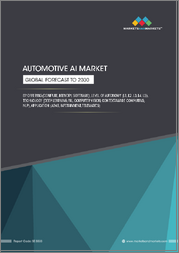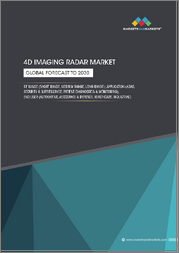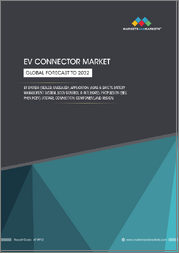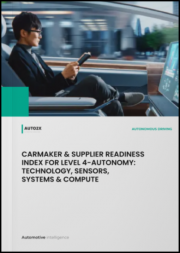
|
시장보고서
상품코드
1548966
레벨 4 자율주행에 대한 공급업체의 준비 : 센서, 시스템, 전략, 시장 점유율Supplier Readiness for Level 4 Autonomy: Sensors, Systems, Strategy, Market Shares |
||||||
이 보고서의 순위는 ADAS Tier 1TOP 20사(APTIV, Bosch, Continental, Denso, Mobileye, Valeo, ZF, Baidu, Alibaba, Amazon, Huawei, Foxconn 등)를 다루고 있습니다.
- 레벨 1- 4 주행·주차를 실현하기 위한 센서·기능·컴퓨팅·소프트웨어 관한 , 공급업체 각사의 기술적 대응력에 대해 파악합니다.
- 파트너십, 투자, M&A, 신제품 발표, 공급망, 비즈니스 모델 등의 전략을 이해합니다.
- 시장 인사이트 : 시장 우위성, 각사 ADAS로부터의 매출, 신규 참여에 의한 경쟁 구도의 변화.
어떤 ADAS 공급업체가 레벨4 수준의 자율주행을 지원하는가?
주요 분석 결과
- 기존의 1단계 공급업체가 ADAS 시장을 주도하고 있지만, 변화와 경쟁에 대한 문제에 직면해 있습니다.
- 중국의 신흥 공급업체와 신규 진입 기술업체들이 ADAS 및 전동화 분야의 주요 1단계 리더십을 위협하고 있습니다.
- 지각, 컴퓨팅, AI, SDV, 새로운 시장에서의 새로운 기회
- 공급업체는 기술 투자를 지속하고, 파트너십을 강화하며, 고객 중심의 비즈니스 모델을 구축해야 합니다.
Auto2x는 "레벨4 자율주행 공급업체 준비도 순위" 보고서를 발표했습니다. 이 보고서에서는 첨단운전자보조시스템(ADAS) 경쟁 환경의 진화 및 기술 프로바이더들의 레벨4 자율주행 로드맵에 대한 분석 내용을 제공합니다.
이 순위는 APTIV, Bosch, Continental, Denso, Mobileye, Valeo, ZF, Baidu, Alibaba, Amazon, Huawei, Foxconn 등 ADAS Tier 1 상위 20개 기업을 대상으로 합니다.
이 보고서는 공급업체의 준비 상태를 평가하기 위해 다음과 같은 항목을 수치화했습니다.
- 레벨 1-4 주행 및 주차를 실현하기 위한 센서, 기능, 컴퓨팅 소프트웨어에 대한 공급업체의 기술적 대응력.
- 공급업체별 전략: 파트너십, 투자, M&A, 신제품 발표, 공급망, 비즈니스 모델 등
- 각 공급업체의 시장내 포지셔닝, ADAS를 통한 매출 창출
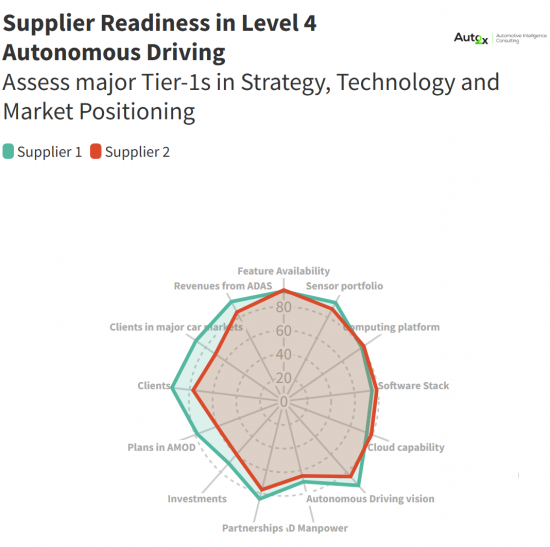
대상 독자
- 자동차 OEM 및 Tier 1/2 공급업체의 엔지니어링, 전략, 마케팅, R&D 및 혁신 담당자들
- 자동차 시장 진출을 고려하고 있는 기술 기업의 혁신 관리자
- 자동차 산업을 전문으로 하는 투자자 및 재무 분석가
- 자동차 산업 컨설턴트 및 전략가
독자의 혜택
- ADAS 공급업체의 상황을 종합적으로 이해할 수 있습니다.
- 자율주행 기술 파트너 및 인수 대상을 식별할 수 있습니다.
- 기존 기업과 신규 진출기업의 경쟁력 평가
- 연구개발 투자 및 시장 포지셔닝에 대한 전략적 결정을 안내할 수 있습니다.
- 자율주행의 미래를 형성하는 새로운 동향과 기술을 이해할 수 있습니다.
왜 대응력 수준이 중요한가?
자율주행 경쟁에서 성공하기 위해 공급업체는 다음 세 가지 측면에서 경쟁력을 갖춰야 합니다.
- 기술 경쟁력
- 전략 실행력(파트너십 및 투자에 대한 강력한 네트워크), 그리고
- 시장 점유율을 확보하기 위한 강력한 시장 포지셔닝
전략
- 적절한 시기에 적절한 기술 및 시장에 투자함으로써 불안정한 상황 속에서 변화하는 시장 수요를 예견하고,
- 적절한 시점에 적절한 기술 및 시장에 투자합니다.
- 시장 재편(새로운 혁신, 아시아 지역 매출 풀의 이동 등)에 따른 새로운 매출 풀을 식별합니다.
미래를 내다보는 기술
- 레벨 3/4 자율주행에 필요한 차세대 소프트웨어/하드웨어(DC, 컴퓨팅, 4D 영상레이더 등) : 누가 우위를 점할 것인가?
- 새로운 주행 및 주차 기능 등장: 경쟁력 있는 솔루션을 제공하기 위해 누가 혁신을 주도하고 있는가?
시장 리더십
- 변화하는 니즈와 신흥 시장에 대한 적응: 새로운 매출 창출 또는 유지
- 리더를 위협하는 신규 시장 진출기업: AI-클라우드 및 자체 개발 부서를 보유한 대형 테크 기업의 등장
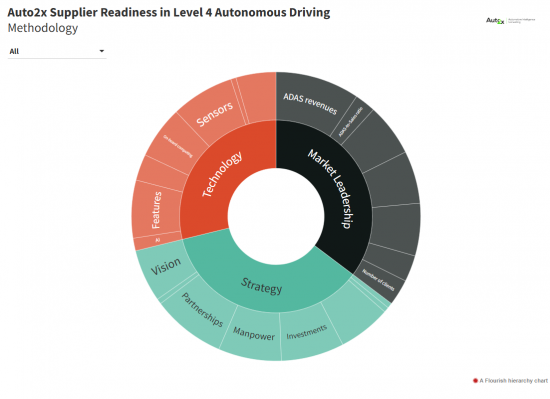
전략 실행에는 강력한 비전, 파트너십, 투자, M&A가 포함됩니다.
인터랙티브 그래프를 통해 주요 공급업체와 자동차 제조업체의 전략에 대해 알아볼 수 있습니다.
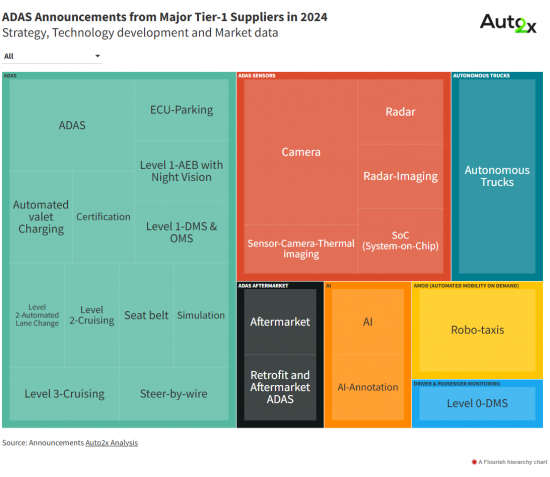
기술경쟁력 내용 :
- 자가용, 자율주행 트럭, 공유 모빌리티 등 이용 사례를 위한 레벨 1-4 기능의 강력한 포트폴리오(고속도로 쇼퍼, 도시형 발레파킹 등 레벨 4 기능은 개발 중);
- 종합적이고 견고한 센서 세트(이미지 레이더, 고체 LiDAR 등).
- 중앙집중화된 E/E 아키텍처, 소프트웨어 스택, 검증 및 인증 등의 기능.
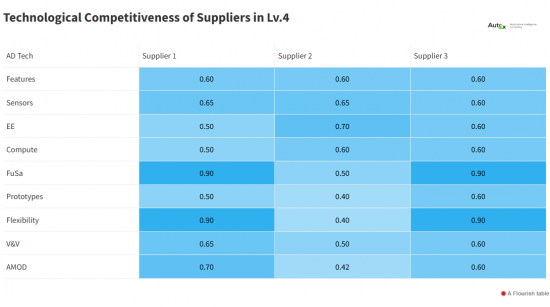
Bosch 사례 - 세계 최대 자동차 부품 공급업체
- ADAS 기능: 보쉬는 L4-Highway 기능을 개발하고 있지만, 현재로서는 APTIV와 같은 다른 Tier 1이 이 기능에서 더 강력한 능력을 가지고 있다고 평가했습니다.
- 센서: 보쉬는 ADAS에서 강력한 위치에 있지만 레벨 3/4에서는 더 많은 혁신이 필요하며, LiDAR와 슈퍼컴퓨터를 포트폴리오에 추가한 것은 올바른 방향이지만 LiDAR에서 다른 Tier 1 (Mercedes-Benz의 L3용 Valeo)와 경쟁하고 있습니다. Mercedes-Benz의 L3용 Valeo) 와의 경쟁에 직면해 있습니다.
- 검증:보쉬는 'VVM'라는 연구 프로젝트를 주도했습니다. VVM은 레벨 4 및 레벨 5 자율주행차 검증 및 인증 방법을 의미하며, 2019년 7월 11일에 시작되어 4년간 진행되었습니다. 두 컨소시엄 리더의 주도하에 연방경제연구개발부의 자금 지원을 받아 23개의 유명한 산업 및 연구 파트너가 공동으로 합법적으로 실행 가능하고 시간 효율적이며 비용 효율적인 검증 및 유효성 확인 방법을 개발합니다. VVM은 복잡한 도시 교차로에서의 활용을 예로 들어 가상 테스트와 현장 테스트를 결합한 본질적인 혁신을 개발할 예정입니다.
- 로보택시: Daimler와 Bosch는 도시 환경에서의 L4 로보택시 컨소시엄을 구성했으나 21년 8월에 종료되었으며, Bosch는 센서 공급업체로서 센서 개발 및 Daimler와의 파트너십의 일환으로 컴퓨팅 플랫폼을 개발하고 있습니다. 보쉬는 L3용 소프트웨어를 독자적으로 개발하고 있다(현재 다른 L4는 지원하지 않는다).
시장에서의 포지셔닝
이 매개 변수는 다음과 같은 내용을 반영합니다.
- ADAS 센서 및 기능의 고객사 수: 자동차 제조업체, 트럭 제조업체, AMOD 포함
- 상위 4개 주요 시장 고객 수: 중국, 미국, EU, 일본, 일본
- ADAS 매출
- 시장 점유율: 센서별, 기능별, 지역별 시장 점유율
- ADAS 매출 대비 ADAS 비율: ADAS에 대한 집중도 반영
ADAS 공급업체들 시장 리더십 동향
- 상위 15개 기업의 2023년 자동차 판매액은 3,600억 유로였습니다.
- 상위 10개 기업의 2023년 연구개발비는 257억 유로였습니다. R&D 비용은 Bosch가 1위, ZF, Denso가 그 뒤를 이었습니다.
- Mobileye는 Tier 1 전체에서 가장 높은 연구개발 강도를 가지고 있으며, Bosch, Valeo가 그 뒤를 잇습니다.
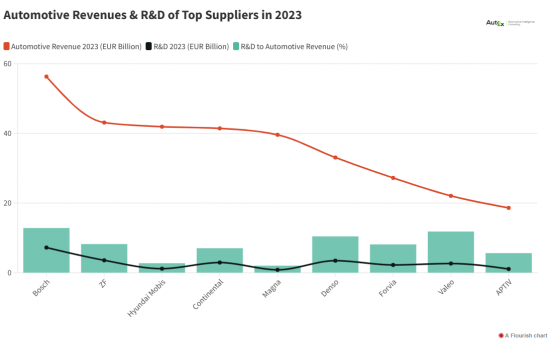
어떤 공급업체가 자율주행 모빌리티의 새로운 시대를 맞이할 준비가 되어 있는가?
"Auto2x는 기술 경쟁력, 전략 실행력, 시장 포지셔닝을 기준으로 주요 1등급 공급업체와 신규 업체들의 대응력 수준을 평가했습니다."
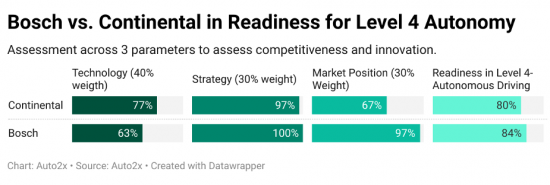
첫 번째 매개변수인 기술 경쟁력는 센서, 기능, 아키텍처, 소프트웨어 스택, 혁신(특허) 등 제품 포트폴리오를 반영합니다.
Auto2x는 APTIV와 Continental이 LiDAR, 소프트웨어 스택, 컴퓨팅 플랫폼에서 성숙한 보트 제품/서비스 제공을 통해 레벨 4 자율주행 기술에서 높은 준비 수준을 가지고 있다고 평가합니다.
Baidu는 Apollo의 강점을 통해 경쟁력 있는 기술을 제공합니다.
- 두 번째 매개변수인 전략 실행력는 공급업체 파트너십, 투자, ADAS 인력, 자율주행 모빌리티 분야에서의 활동 등을 포함합니다.
Bosch와 Mobileye는 강력한 자체 역량, 고성장 분야의 파트너 생태계, 주요 시장에 대한 투자로 이 매개변수를 선도하고 있습니다.
Continental은 설계, 제조, 검증, 시스템 통합 및 기능의 새로운 서비스 확장에 이르기까지 100% 시스템 공급업체입니다. 따라서 Continental은 유리한 위치에 있습니다.
- 세 번째 매개변수인 시장 포지셔닝는 센서 및 기능별 ADAS 매출, 센서 시장 점유율, 고객 기반, 지역적 입지를 반영합니다.
Bosch, ZF, Valeo, Denso, Continental과 같은 주요 자동차 1차 공급업체들은 여전히 자동차 매출에서 큰 비중을 차지하고 있습니다.
또한 ADAS, 전동화 및 새로운 모빌리티 비즈니스 모델로부터의 매출도 증가하고 있습니다. 상위 12개 공급업체의 ADAS 매출은 2021년 전년 대비 12.5% 증가한 160억 유로를 기록했으며, Auto2x는 2025년까지 두 배로 증가한 350억 유로를 기록할 것으로 예상하고 있습니다.
Continental은 주로 카메라 시장에서의 우위를 바탕으로 2015-2018년까지 ADAS 시장 매출을 주도했습니다.
그러나 2019년에는 보쉬에 추월당했고, 이후 ADAS 매출에서 시장을 선도하고 있으며, ADAS 관련 OEM과의 계약과 더 높은 수준의 자동화를 위한 운전 및 주차 기능을 지원하는 능력은 이 회사의 강점입니다.
- 종합적인 대응력: 레벨 4의 자율주행에서 공급업체의 대응력 순위는 전략(30% 가중치), 기술(40%), 시장 지위(30%)의 세 가지 매개변수 능력을 기준으로 합니다.
Auto2x에 따르면 보쉬는 레벨 1-2 기능의 센서 매출으로 ADAS 시장을 선도하고 있지만, 레벨 4 자율주행에 대한 기술 준비는 뒤쳐져 있다고 합니다.
또 다른 성공 사례는 인텔의 자율주행 전략을 주도하며 ADAS 분야에서 큰 점유율을 차지하고 있는 모빌아이(Mobileye)다. 모빌아이는 레벨4 자율주행 대응도 기준 공급업체 순위에서 상위 3위를 차지했습니다.
유럽계 공급업체가 선두를 달리고 있지만, 중국계 공급업체가 추격하고 있음
ZF와 Continental의 ADAS 매출 2,000억 유로 돌파, 그러나 여전히 과제는 남아있습니다.
ADAS 세계 매출 순위에 따르면 ADAS 자동차 부품 공급업체 중 상위 4개 업체는 모두 유럽의 Bosch, Valeo, ZF, Continental이며, 2022년 자동차 생산량이 4% 증가하고, 레벨 2-3 시스템의 센서 장착률이 높아진 것으로 나타났습니다, ADAS 매출과 수주에 기여했습니다.
- ZF는 2022년 ADAS 매출이 2021년 18억 유로에서 33% 증가한 24억 유로를 달성했으며, ZF는 Auto2x가 발표한 2021년 ADAS 매출 세계 순위에서 11% 시장 점유율을 차지하며 3위를 차지했습니다.
- Continental의 ADAS 매출은 2021년 17억 유로에서 2022년 21억 유로로 23% 증가했으며, ADAS는 Continental의 자동차 부문 매출의 11%를 차지합니다.
그러나 주요 자동차 부품 제조업체들은 AI 및 소프트웨어 역량을 개발하고 소프트웨어 비즈니스 모델로 진출하여 새로운 경쟁에 직면하기 위해 더 많은 변화에 직면하고 있습니다.
레벨 4의 자율성을 달성하기 위해 자동차 기업은 어떤 문제에 직면하고 있는가?
자동차업체들은 레벨4 자율성을 실현하기 위해 첨단 센서 기술과 방대한 데이터를 실시간으로 처리할 수 있는 고성능 컴퓨팅 플랫폼의 필요성 등 몇 가지 도전 과제에 직면해 있습니다.
자율주행차의 규정 준수와 사회적 수용성을 확보하기 위해서는 규제 장벽과 안전 기준을 넘어야 합니다.
성공적인 배포에 필요한 인프라와 기술 생태계를 구축하기 위해서는 많은 투자와 연구개발, 파트너십이 필요합니다.
주요 자동차 ADAS 공급업체는 어떤 위험에 직면하고 있는가?
공급업체들은 경쟁의 심화, 특히 AI와 클라우드 기술을 활용하는 대형 하이테크 기업 및 신규 기업과의 경쟁 심화로 인한 위험에 직면해 있으며, 이는 기존 공급망을 파괴할 수 있습니다.
자동차 제조업체가 모빌리티 서비스 프로바이더로 변모함에 따라 공급업체들은 소프트웨어 중심 모델로 빠르게 전환해야 하는데, 이를 위해서는 많은 투자와 구조조정이 필요할 것으로 보입니다.
또한 하드웨어에서 소프트웨어로의 수익화 전환은 전통적인 수입원에 의존하는 공급업체에게 도전이 될 것이며, 경쟁력을 유지하기 위해 사업 전략을 신중하게 선택해야 합니다.
자율주행의 새로운 기회
소프트웨어 온 휠 혁명이 모빌리티의 미래를 결정할 것입니다.
전동화, 자율주행, 공유 모빌리티, 커넥티비티는 보다 전문적인 소프트웨어 개발을 촉진할 것입니다. 하드웨어 중심의 시스템 대부분이 표준화되고 상품화될 것입니다.
고급 소프트웨어가 탑재된 ECU 증가는 비용 증가, 차량내 소프트웨어의 복잡성 증가, 차량 기능 최적화에 대한 제약으로 이어집니다.
차세대 디지털 자동차는 새롭고 다양한 기술과 복잡한 논리 운영을 통합해야 하며, 하드웨어 아키텍처는 고급 소프트웨어 기능과 업데이트 가능성을 지원해야 합니다.
새로운 파트너십과 새로운 비즈니스 모델이 탄생하고 있습니다.
잠재력이 높은 소프트웨어 중심의 새로운 기능에는 어떤 것이 있는가?
소프트웨어는 자동차 산업의 디지털화에 대한 해답이지만, 이를 실현하는 데는 어려움이 있습니다.
SDV의 주요 기술 컴포넌트의 주요 혁신 클러스터는 다음과 같습니다.
- EE 아키텍처: 중앙 집중식 아키텍처 개발에서 주요 자동차 제조업체 및 공급업체의 로드맵과 파트너십을 평가합니다.
- BMW가 통합한 Aptiv의 액티브 세이프티 도메인 컨트롤러(Active Safety Domain Controller)
- Visteon의 Domain Controller SmartCore - Mercedes Benz 출시;
- ZCU(Zone Oriented Control Unit) : 차량을 구역으로 나누고 각 구역을 구역 ECU에 통합(하위 ECU는 차량 기능을 실현하기 위한 처리를 수행하지 않음), 보쉬의 구역 지향적 E/E 아키텍처;
- 크로스 도메인 집중 유닛(CDCU) : 여러 도메인의 기능을 하나의 ECU에 통합한 것(DCU의 아키텍처와 유사), 예: 보쉬의 차량 중심 ECU.
- CarOS: Google의 Android Automotive OS의 채택이 증가하고 있으며, MBUX 및 기타 기업이 제공하는 경쟁 제품에 대해 알아본다;
- 오픈소스 소프트웨어 개발
- 클라우드: 클라우드 기반 ADAS 개발을 가능하게 하는 차량용 클라우드의 등장, 각 자동차 제조업체의 제품 개발, 마이크로소프트, 아마존 등의 역할;
- OTA(Over-the-Air) 업데이트와 features-on-demand의 기회;
- 디지털 트윈
AI와 클라우드 컴퓨팅의 혁신은 자율주행에 어떤 영향을 미칠까?
AI 및 클라우드 컴퓨팅과 같은 신기술은 고급 데이터 처리, 실시간 의사결정, 확장 가능한 소프트웨어 업데이트가 가능하므로 자율주행의 미래에 매우 중요합니다.
AI는 머신러닝과 차량내 어시스턴트를 통해 차량의 인식과 자율성을 강화하고, 클라우드 컴퓨팅은 효율적인 기능 개발 및 시스템 통합을 지원합니다.
클라우드 컴퓨팅은 효율적인 기능 개발과 시스템 통합을 지원합니다. 이 두 가지의 결합은 더 높은 수준의 자동화로의 전환을 촉진하고 전체 차량의 성능과 안전성을 향상시킬 수 있습니다.
AI와 클라우드 컴퓨팅의 통합은 자율주행차의 소비자 경험을 변화시킬 것입니다.
AI와 클라우드 컴퓨팅의 통합은 맞춤형 엔터테인먼트, 실시간 내비게이션 지원 등 개인화된 사내 서비스를 제공함으로써 자율주행차의 소비자 경험을 크게 향상시킬 수 있습니다.
클라우드 컴퓨팅은 지속적인 업데이트와 기능 향상을 통해 차량이 최신 기술과 안전 기능을 유지할 수 있게 해줍니다.
또한 AI 기반 가상 비서는 원활한 상호작용을 제공하여 이동 중 편리함과 전반적인 만족도를 향상시킬 수 있습니다.
새로운 공급업체와 대형 기술기업이 어떻게 대형 Tier 1을 혼란에 빠뜨릴 수 있는가?
전통적인 ADAS 공급업체는 여전히 자동차 공급업체 매출의 대부분을 차지하고 있습니다. 그러나 자동차를 혁신하는 AI, 클라우드 소프트웨어 전문성을 활용하는 미국, 중국 등 거대 기술 기업과의 경쟁에 직면해 있습니다.
2020년대에는 자동차 제조업체들이 비용 절감을 위해 보다 보편적인 플랫폼으로 전환하고, 기존 기업은 신규 시장 진출기업과 경쟁하기 위해 수직 통합형 자산 중심 비즈니스 모델에서 탈피해야 하므로 자동차의 소프트웨어 가치가 하드웨어를 능가할 것으로 예상됩니다. 될 것으로 보입니다.
소프트웨어는 새로운 기능, 컨텐츠, 개인화된 새로운 경험 등 제품 차별화에 매우 중요한 역할을 합니다.
이 보고서는 하이테크 기업이 기존 공급망에 진입하거나 기존 공급망을 파괴할 수 있는 몇 가지 기회를 확인했습니다.
- 자율주행을 위한 차세대 인지 하드웨어
- 자율주행용 Peta-Ops 칩과 같은 컴퓨팅
필요한 처리 능력 :
- Lv.2: 10TOPS(tera operations per second)의 처리 능력을 필요로 합니다.
- Lv.4 : 100 TOPS 이상
- Lv.5: 1,000 TOPS의 처리 능력이 필요합니다.
- AI: 무인운전 및 HMI를 위한 AI - 차량 탑재형 AI 비서 등
- 데이터베이스 비즈니스 모델(차량 탑재형 E-Commerce 등)
- 5G-6G, 커넥티드 인프라, 스마트 시티
- 자율주행 공유 모빌리티와 무인 배송
공급업체는 어떻게 경쟁력을 유지하고 우위를 점할 수 있는가?
자동화에서 관련성을 유지하고 경쟁 우위와 시장 점유율을 확보하기 위해 공급업체는 무엇을 해야 하는가?
공급업체는 진화하는 자율주행 수요에 대응하기 위해 첨단 감지 하드웨어, AI, 클라우드 컴퓨팅 등 차세대 기술에 투자해야 합니다.
또 다른 중요한 측면은 자동차 제조업체가 더 높은 자율성을 개발하는 데 필요한 자율주행 소프트웨어와 센서의 역량을 구축하는 것입니다.
또한 새로운 수입원을 발굴하고, 혁신적인 파트너와 협력하여 높은 성장 기회를 확보하기 위해 전략을 조정해야 합니다.
"주요 자동차 제조업체와 상업 및 제품 개발 파트너십을 맺고 커넥티드, 전기자동차, ADAS 로드맵을 지원합니다. 급성장하는 중국 시장에서 AI와 커넥티비티 분야는 새로운 AD 공급업체가 세계 1등 업체로부터 시장 점유율을 확보하는 데 매우 중요합니다.
또한 공급업체는 시장에서 경쟁력을 유지하기 위해 지속적으로 경쟁을 평가하고 제품 제공을 강화해야 합니다.
마지막으로 로봇 택시, 라스트마일 배송 등 혁신적인 기술과 비즈니스 모델에 대한 투자를 촉진하는 것입니다.
신규 시장 진출기업을 위한 제안
신규 공급업체를 위한 시장 진출 전략의 포인트는?
신규 공급업체의 주요 시장 진출 전략은 기존 기업과의 전략적 파트너십 형성, 혁신 기술에 대한 투자, 자율주행 분야의 틈새 시장에 집중하는 것 등입니다.
진출 가능성이 있는 기술로는 차세대 인지 하드웨어, 자율주행용 AI, 첨단 컴퓨팅 솔루션 등이 있습니다.
- Lenovo는 NVIDIA 및 Valeo와 협력하여 AD-DC 시장에 Tier 1 공급업체로 진입했습니다.
- 화웨이는 최근 'Focused Innovation for Intelligent Vehicles'라는 주제로 열린 제품 발표회에서 ADAS 센서(4D 이미징 레이더), HMI(AR-HUD)에 초점을 맞춘 자율주행 분야 신제품을 발표했습니다.), HMI(AR-HUD)에 초점을 맞춘 자율주행 분야 신제품을 발표했습니다.
- Samsung Electronics는 테슬라와 공동으로 HW4.0용 칩을 개발한다;
Samsung Electronics가 진출할 수 있는 기술과 국가는?
새로운 공급업체에게 유망한 국가로는 중국, 미국, 그리고 자율주행 솔루션에 대한 수요가 급증하고 있는 유럽을 꼽을 수 있습니다.
목차
제1장 레벨 4 자율주행에 대한 공급업체 대응 상황
- 1. 공급업체 대응 상황 레벨 : 조사 방법
- 2. 레벨 4 자율주행(AD)에 대한 대응 상황 : 종합 순위 결과
- 3. 전략 시행 순위 : 개요
- 4. 시장 경쟁력 순위
- 5. 시장 리더십 순위 : 개요
- 6. ADAS-AD 공급업체에서의 기회
- 7. 기회 레이더 : 행동·대응·관찰에 의한 순위
- 8. 기존 기업·신규 참여 기업에 대한 제안
- 9. Tier 1공급업체 포트폴리오 갭
- 10. 리더십을 위협하는 리스크
제2장 전략과 시행
- 1. 공급업체 ADAS-AD전략 동향
- 2. 공급업체 레벨 4-AD에 대한 로드맵
- 3. AD용 소프트의 추진을 위한 공급업체의 연구개발(R&D)(2023년)
- 4. 신제품의 발매(2024년)
- 5. 주요 협업(2024년)
- 6. AMOD(온디맨드 자동 모빌리티) 전략
- 7. 레벨 3- 4 자율주행 플랫폼 공급업체
- 8. 자율주행에 대한 투자 동구(2024년)
- 9. 새로운 비즈니스 모델 : SaaS, CaaS, DaaS, VaaS, Tier-X
- 10. Continental 자동차 부문 스핀오프
- 11. Lenovo가 새로운 DC Tier 1으로서 AD시장에 참여
- 12. Mobileye 이미징 레이더
- 13. Valeo 브레인 부문
- 14. Qualcomm
- 15. AI 규제와 윤리 동향
제3장 기술 경쟁력
- 1. 기술 경쟁력 순위
- 2. 주요 Tier 1공급업체 ADAS L0-L4기능 가용성
- 3. 주요 Tier 1공급업체 센서·포트폴리오
- 4. ADAS 레이더와 카메라 벤치마크
- 5. 차세대 레이더·카메라·LiDAR
- 6. 운전자와 승객/승무원 모니터링(DMS-OMS-PMS)
- 7. 차량내 컴퓨팅의 부상
- 8. 레벨 3- 4자율주행을 위한 데이터 기록
- 9. 커넥티드 자율주행을 향한 E/E 아키텍처의 진화
- 10. 소프트웨어 정의 차량(SDV) 혁신
- 11. ADAS와 자율주행로 코드/노우 코드·솔루션
- 12. 특허·지적재산·과학적 문헌 이노베이터
- 13. Auto2x AD Radar에 의한 ADAS 기능 향후
- 14. 자율주행 생성형 AI와 새로운 응용
- 15. 차량대 차량 통신(V2V, V2I, V2X)
제3장 시장 리더십과 포지셔닝
- 1. 자동차 매출에 의한 공급업체 순위(2023년)
- 2. 공급업체 매출 : ADAS 소프트웨어의 분류별
- 3. ADAS 매출에 의한 공급업체 순위(2015-2023년)
- 4. 77 GHz 레이더 공급업체 시장 점유율
- 5. 주요 AD허브가 되기 위한 중국의 강점
- 6. 인도 레벨 2-ADAS의 부상
제5장 ADAS와 자율주행 공급업체 기회
- 1. ADAS 센서 컨텐츠의 증가
- 2. 센서 시장의 예측과 TAM
- 3. L3/L4용 LiDAR의 매출 예측
- 4. ADAS용 소프트웨어의 수요 증가
- 5. 소프트웨어 정의 차량(SDV)
- 6. ADAS 서브스크립션
- 7. AMOD(온디맨드 자동 모빌리티)
- 8. 레벨3-4규제
- 9. 자동차 메타버스
- 10. 자동 배달
- 11. 레벨3/4 자율주행용 보험
- 12. 자동 채굴
The rankings cover the Top-20 ADAS Tier-1s, including APTIV, Bosch, Continental, Denso, Mobileye, Valeo, and ZF, Baidu, Alibaba, Amazon, Huawei, Foxconn and others.
- Learn about the technological capabilities of suppliers in sensors, features, computing and software to deliver Level 1-4 cruising and parking.
- Understand the strategies, including partnerships, investments, M&A, new product launches, supply chain and business models.
- Get insights on who is better positioned in the marketplace, their revenues from ADAS and how new entrants will shape competition.
Which ADAS Suppliers are Ready for Level 4 Autonomous Driving?
Key findings
- Incumbent Tier-1 suppliers lead the ADAS market, but they face challenges to transform and fight the competition
- Emerging Chinese Suppliers and tech entrants threaten the leadership of major Tier-1s in ADAS & Electrification
- New opportunities in perception, computing, AI, SDVs and new markets
- Suppliers should continue investing in tech, strengthen partnerships and build customer-centric business models
Auto2x has released its "Supplier Readiness in Level 4 Autonomous Driving Rankings" report, offering insights into the evolution of the competitive landscape of Advanced Driver Assistance Systems (ADAS) and the roadmaps to Level 4 autonomous driving from technology providers.
The rankings cover the Top-20 ADAS Tier-1s, including APTIV, Bosch, Continental, Denso, Mobileye, Valeo, and ZF, in addition to Baidu, Alibaba, Amazon, Huawei, Foxconn and others.
To assess the Supplier Readiness we quantify
- their technological capabilities of suppliers in sensors, features, computing and software to deliver Level 1-4 cruising and parking.
- their strategies, including partnerships, investments, M&A, new product launches, supply chain and business models.
- how they are positioned in the marketplace, their revenues from ADAS

Who Should Read This Report:
- Engineering, Strategy, Marketing, R&D and Innovation functions in Automotive OEMs and Tier 1-2 Suppliers
- Innovation Managers in Technology companies exploring automotive market entry
- Investors and financial analysts focused on the automotive sector
- Automotive industry consultants and strategists
How Readers Will Benefit:
- Gain a comprehensive understanding of the ADAS supplier landscape
- Identify partners or acquisition targets for autonomous driving technology
- Assess competition from both established players and new entrants
- Guide strategic decisions around R&D investments and market positioning
- Understand emerging trends and technologies shaping the future of autonomous driving
Why does a Readiness Level matter?
To succeed in the Autonomous Driving race suppliers must be competitive across 3 parameters:
- technological competitiveness,
- strategy execution (strong network of partnerships and investments), and
- strong market positioning to capture market share.
Strategy
- Foresee changing market needs amid volatility by investing in the right tech, market at the right time.
- Identify new revenue pools from new innovation, market consolidation, such as shift of revenue pools in Asia.
Future-proof Technology
- Next-gen SW-HW needed for Level 3/4 autonomy e.g., DC, compute, 4D imaging radar. Who has an edge?
- New cruising and parking features emerge: Who is innovating to offer competitive solutions?
Market Leadership
- Adapt to changing needs and emerging markets to build new revenues or maintain.
- Leaders are threatened by new entrants such as Tech Giants with AI, Cloud or in-house

Strategy execution includes a powerful vision, partnerships, investments and M&A
Use the interactive graph to learn about the strategies of major suppliers and carmakers.

Technological competitiveness includes
- a strong portfolio of Level 1-4 features for private cars, autonomous trucks, shared mobility and other use cases (Level 4 features, such as Highway Chauffeur, City and Valet Parking are in development);
- a comprehensive and robust set of sensors (e.g. imaging radar, solid-state lidar).
- capabilities in centralised E/E Architecture, SW Stack, Validation-Verification and others.

Let's have a look at some of them taking the example of Bosch, the world's biggest automotive supplier by revenue.
- ADAS Features: Bosch is developing L4-Highway features but we assess that other Tier-1s, such as APTIV, have stronger capabilities at the moment in this feature.
- Sensors: Bosch has a strong position in ADAS but needs further innovation for L3-4. The addition of Lidar and supercomputers to its portfolio is in the right direction but the company faces competition for Lidar from other Tier 1s, such as Valeo for Mercedes-Benz's L3.
- Validation: Bosch led a research project called 'VVM' , short for verification and validation methods of Level 4 and Level 5 autonomous vehicles, launched on 11 July 2019 with a duration of 4 years. Under the leadership of two consortium leaders Bosch and BMW, with funding from the Federal Ministry for Economic Affairs and Energy, 23 well-known industry & research partners will jointly develop legally viable, time-efficient and cost-effective verification and validation methods. Using the example of a complex urban crossroads application, VVM will develop essential innovations combining virtual and real-life tests.
- Robotaxis: Daimler - Bosch had a consortium for L4 robotaxis in urban environments that ended in Aug'21. Bosch is the sensor supplier, i.e. developing the sensors, and computing platforms as part of its partnership with Daimler who is the lead partner and developer of the SW. Bosch is developing SW on their own for L3+ (not any other L4 as of today).
Market Positioning
This parameter captures:
- Number of clients in ADAS sensors and features, incl. Carmakers, Trucks, AMOD
- Clients in Top-4 major markets: China, USA, EU, Japan
- ADAS revenues
- Market shares in sensors, features and regional
- ADAS-to-Sales ratio to show their focus on AD
Trends in Market Leadership of ADAS Suppliers
- The Top-15 Suppliers recorded Euro-360 Billion in Automotive revenue in 2023.
- The Top-10 Suppliers recorded Euro-25.7 Billion in R&D spending in 2023. Bosch led R&D expenditure followed by ZF and Denso.
- Mobileye has the highest R&D intensity across Tier-1s, followed by Bosch and Valeo

Which suppliers are better prepared for the new era of Autonomous Mobility?
"Auto2x assessed the readiness levels of major Tier-1 suppliers and emerging players based on their technological competitiveness, their strategy execution and their market positioning."

The first parameter, Technology Competitiveness, captures the product portfolio of sensors, features, architecture, software stack and innovation (patents).
Auto2x assesses that APTIV and Continental have high readiness levels in Level 4 Autonomous Driving Technology due to their mature offering in Lidar, Software stack and Computing Platforms.
Baidu offers competitive technology due to Apollo's strengths.
- Strategy Execution, the 2nd parameter, covers a supplier's partnerships, investments, ADAS manpower, activities in autonomous mobility and more.
Bosch and Mobileye lead the pack in this parameter, with strong in-house capabilities, a partner ecosystem in high-growth areas and investments in key markets.
Continental is a 100% system supplier from design and manufacturing to validation and expansion to new services in system integration and functions. This makes them well-positioned.
- Market Positioning, the 3rd parameter, captures the volume of ADAS revenues from sensors and features, sensor market share, client base and geographical presence.
Major Automotive Tier-1 Suppliers like Bosch, ZF, Valeo, Denso and Continental still maintain the lion's share in terms of automotive revenues.
Furthermore, their revenues from ADAS, electrification and new mobility business models are increasing. ADAS revenues from the Top-12 Suppliers rose 12.5% in 2021 y-y to Euro-16 Billion. Auto2x expects it will double by 2025 to Euro-35 Billion.
Continental led the ADAS market by revenues between 2015 and 2018, mainly by capitalising on its dominance in the camera market.
But they were overtaken by Bosch in 2019, who leads the market by ADAS revenues since then. The contracts with OEMs for ADAS and the ability to support driving and parking features for higher levels of automation are strengths.
- Overall Readiness Level: The Ranking of Suppliers Readiness in Level 4 Autonomous Driving is based on their competence in three parameters, Strategy (30% weight), Technology (40%) and Market Position (30%).
Auto2x found that Bosch leads the ADAS market by revenues from sensors for Level 1-2 features, but they lag in Technology Readiness for Level 4 Autonomous Driving.
Another success story is Mobileye which spearheads INTEL's Autonomous Driving strategy and has captured a large share in ADAS. Mobileye ranks at the Top-3 of Auto2x's Ranking of Suppliers by Readiness in level-4 Automated Driving.
European suppliers lead the race but Chinese Suppliers are catching up
ZF and Continental broke the Euro-2 Billion mark in ADAS revenues, but challenges remain
The Top-4 Automotive Suppliers of ADAS are all European, Bosch, Valeo, ZF and Continental, according to Global ADAS Ranking by Revenues. The 4% growth in automotive production in 2022 and the higher sensor fitment for Level 2-3 systems benefited their ADAS sales and Order Books.
- ZF achieved 33% growth in ADAS revenues in 2022 to Euro-2.4 Billion, from Euro-1.8B in 2021. ZF ranked 3rd in the Global ADAS Ranking by Revenues in 2021 from Auto2x with an 11% market share.
- Continental saw 23% growth in ADAS sales to Euro-2.1 Billion in 2022, from Euro-1.7B in 2021. ADAS accounted for 11% of Continental's Automotive revenues.
But major automotive suppliers face further transformation to develop capabilities in AI and software, expand into software business models and face new competition.
What challenges do automotive companies face in achieving Level 4 autonomy?
Automotive companies face several challenges in achieving Level 4 autonomy, including the need for advanced sensor technology and high-performance computing platforms to process vast amounts of data in real time.
Regulatory hurdles and safety standards must be navigated to ensure compliance and public acceptance of autonomous vehicles.
Significant investments, research and development, and partnerships are required to build the necessary infrastructure and technology ecosystem for successful deployment.
What risks do leading Automotive ADAS Suppliers face?
Suppliers face risks from increased competition, particularly from tech giants and emerging players that leverage AI and cloud technologies, potentially disrupting traditional supply chains.
The transformation of carmakers into mobility service providers pressures suppliers to adapt quickly to software-driven models, which may require significant investment and restructuring.
Additionally, the shift from hardware to software monetization poses challenges for suppliers reliant on traditional revenue streams, necessitating the refinement of their business strategies to remain competitive.
New opportunities in Autonomous Driving
Software-on-Wheels revolution will determine Mobility's future
Electrification, automated driving, shared mobility and connectivity push for more dedicated software development. A large part of hardware-oriented systems becomes more standardized and commoditized.
The growing number of ECUs with sophisticated software leads to significant cost increases, higher in-vehicle software complexity and constraints in optimising vehicular functions.
Next-generation Digital vehicles must integrate new, diverse technologies and complex logical operations; the hardware architecture has to support advanced software functionality and upgradability.
New partnerships and new business models are emerging.
What are some key new Software-driven features with high potential?
Software is the answer to the Digitization of the Automotive Industry but delivery is challenging.
Learn about top innovation clusters across major technological building blocks of SDVs.
- EE Architectures: Assess the roadmaps of leading carmakers and suppliers in the development of centralized architectures and their partnerships;
- Aptiv's Active Safety Domain Controller integrated by BMW,
- Visteon's Domain Controller SmartCore, launched by Mercedes Benz;
- zone-oriented control units (ZCUs), where the vehicle is divided into zones and each zone integrates into a zone-ECU (the sub-ECUs do not perform any processing to realize a vehicle function) e.g. Bosch's zone-oriented E/E architecture;
- cross-domain centralized units (CDCUs), where the functions of more than one domain are consolidated onto a single ECU (similar to the DCU's architecture) e.g. Bosch's vehicle-centralized ECU.
- CarOS: Learn about the rising adoption of Google's Android Automotive OS and the competitive offerings from MBUX and other players;
- Open-source software development
- Cloud: the emergence of automotive cloud as an enabler for cloud-based ADAS development, development of offerings from carmakers and the role of Microsoft, Amazon among others;
- Over-the-Air-updates and the opportunities for features-on-demand;
- Digital Twin
How could innovation in AI and cloud computing impact autonomous driving?
New technologies like AI and cloud computing are crucial for the future of autonomous driving as they enable advanced data processing, real-time decision-making, and scalable software updates.
AI enhances vehicle perception and autonomy through machine learning and in-car assistants, while cloud computing supports efficient feature development and system integration.
Together, they facilitate the transition to higher levels of automation and improve overall vehicle performance and safety.
The integration of AI and cloud computing will change the consumer experience in autonomous vehicles
Integrating AI and cloud computing will significantly enhance the consumer experience in autonomous vehicles by enabling personalized in-car services, such as tailored entertainment and real-time navigation assistance.
Cloud computing allows for continuous updates and feature enhancements, ensuring vehicles remain up-to-date with the latest technology and safety features.
Additionally, AI-powered virtual assistants can provide seamless interaction, improving convenience and overall satisfaction during travel.
How could new suppliers and Tech Giants disrupt major Tier-1s?
Traditional ADAS suppliers still maintain the lion's share in automotive supplier revenues. But they face competition from US, Chinese and other Tech giants who capitalize on their expertise in AI, Cloud and Software transforming automotive.
In the 2020s the vehicle's software value will exceed that of hardware as carmakers shift to more common platforms to achieve cost savings and existing players are forced to move away from vertically integrated, asset-heavy business models to compete with new entrants.
Software will be crucial for product differentiation such as new features, content, and new personalized experiences.
We have identified several opportunities for Tech Companies to enter or disrupt the existing supply chain.
- Next-gen Perception Hardware for Autonomous Driving
- Computing, e.g. Peta-ops chips for Autonomous Driving
"The computing power required for a
- Lv.2 vehicle is 10 TOPS (tera operations per second),
- Lv.4 exceeds 100 TOPS,
- Lv.5 vehicle will require a 1,000 TOPS computing processing power."
- AI: AI for Autonomy and HMI such as in-car AI assistants
- Data-based Business models such as in-car e-commerce
- 5G-6G, Connected Infrastructure and Smart Cities
- Autonomous Shared Mobility and autonomous deliveries
How can Suppliers stay competitive and gain competitive advantage?
What should suppliers do to stay relevant in autonomous driving, gain competitive advantage and market share?
Suppliers should invest in next-generation technologies, such as advanced perception hardware, AI, cloud computing to meet the evolving demands of autonomous driving.
Another important aspect is building competence in Autonomous Driving software and sensors needed by carmakers to develop higher autonomy.
They should also adapt their strategies to identify new revenue pools and collaborate with innovative partners to tap into high-growth opportunities.
By forming commercial and product development partnerships with volume carmakers to support their connected, electric and ADAS roadmaps. The AI and connectivity domains in the booming Chinese market are crucial for new AD Suppliers to claim market share from global Tier-1s.
Additionally, suppliers must continuously assess competition and enhance their product offerings to maintain a competitive edge in the market.
Finally, fuel investments in innovative technologies and business models incl. robotaxis, and last-mile delivery.
Recommendations for new market entrants
What are some key market entry strategies for new suppliers?
Key market entry strategies for new suppliers include forming strategic partnerships with established players, investing in innovative technologies, and focusing on niche markets within the autonomous driving sector.
Technologies with potential for entry include next-gen perception hardware, AI for autonomy, and advanced computing solutions.
- Lenovo has entered the AD-DC market as a Tier-1 Supplier with partnerships with NVIDIA and Valeo.
- Huawei supplies LIDAR and car networking to BAIC for L2+. Huawei has recently launched new products in Autonomous Driving focusing on ADAS sensors (4D imaging radar), HMI (AR-HUD) during their product launch titled 'Focused Innovation for Intelligent Vehicles'.
- Samsung Electronics will work together with Tesla to develop chips for their HW 4.0;
Which technologies show potential for them to enter and which countries?
Countries with promising opportunities for new suppliers include China, the USA, and in Europe, where demand for autonomous driving solutions is rapidly growing.
Table of Contents
1. Supplier Readiness in Level 4 Autonomous Driving
- 1. Methodology for the Supplier Readiness Level
- 2. Findings from the overall ranking of Readiness in Level 4-AD
- 3. Strategy Execution ranking summary
- 4. Technology Competitiveness ranking
- 5. Market Leadership ranking summary
- 6. Opportunities for ADAS-AD Suppliers
- 7. Opportunity Radar: rankings by Act, Prepare, Watch
- 8. Recommendations for incumbents and new market entrants
- 9. Gaps in the portfolios of Tier-1 Suppliers
- 10. Risks that threaten their leadership
2. Strategies and execution
- 1. Trends in Supplier ADAS-AD Strategy
- 2. Supplier roadmaps to Level 4-AD
- 3. R&D of Suppliers in 2023 to drive AD-SW
- 4. New Product Launches in 2024
- 5. Key collaborations in 2024
- 6. Strategies in AMOD (Automated-Mobility-on-Demand)
- 7. Suppliers of Level 3-4 Autonomous Driving Platforms
- 8. Investments in Autonomous Driving in 2024
- 9. New Business Models: SaaS, CaaS, DaaS, VaaS, Tier-X
- 10. Continental's Spin-off of the Automotive Segment
- 11. Lenovo's entry in the AD markets as a new DC Tier-1
- 12. Mobileye's Imaging Radar
- 13. Valeo's Brain segment
- 14. Qualcomm
- 15. AI Regulation and developments of Ethics
3. Technology Competitiveness
- 1. Ranking by Technology Competitiveness r
- 2. ADAS L0-L4 Feature Availability across major Tier-1 Suppliers
- 3. Sensor portfolio of leading Tier-1 Suppliers
- 4. ADAS Radar and Camera benchmarking
- 5. Next-generation radars, camera, lidar
- 6. Driver and passenger / occupant monitoring (DMS-OMS-PMS)
- 7. Rise of on-board vehicle Computing
- 8. Data recording for Level 3-4 Autonomous Driving
- 9. The evolution of E/E Architecture for connected and automated driving
- 10. Innovation in Software-Defined Vehicles (SDV)
- 11. Low-No Code solutions in ADAS and autonomy
- 12. Innovators in Patents, Intellectual Property and Scientific Literature
- 13. Future of ADAS features from Auto2x AD Radar
- 14. Generative AI and new applications in Autonomous Driving
- 15. Vehicle-to-Everything Communications (V2V, V2I, V2X)
3. Market Leadership and Positioning
- 1. Supplier Rankings by Automotive Revenue in 2023
- 2. Supplier Revenues by ADAS-Software divisions
- 3. Ranking of Suppliers by ADAS Revenues 2015-2023
- 4. Supplier market shares in 77GHz radar
- 5. China's strengths to become Top AD Hub
- 6. Rise of Level 2-ADAS in India
5. Opportunities in ADAS and Autonomous Driving for Suppliers
- 1. Rising ADAS sensor content
- 2. Sensor Forecast and TAM
- 3. Forecast of revenues from Lidar for L3/L4
- 4. Rising demand for SW for ADAS
- 5. (SDV) Software-Defined Vehicles
- 6. Subscriptions for ADAS
- 7. AMOD (Automated-Mobility-on-Demand)
- 8. Regulation for Level 3-4
- 9. CarMetaverse
- 10. Autonomous Deliveries
- 11. Insurance for Level 3-4 Automated Driving
- 12. Autonomous mining










